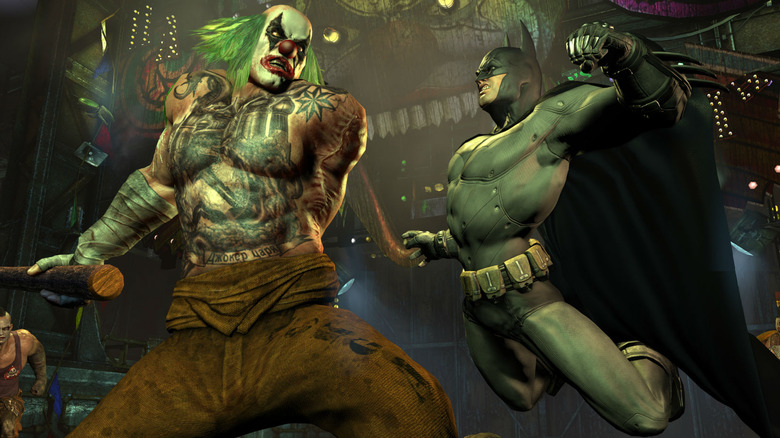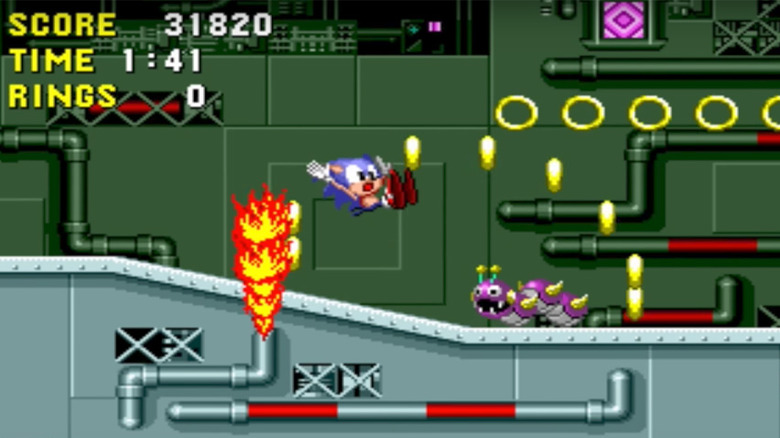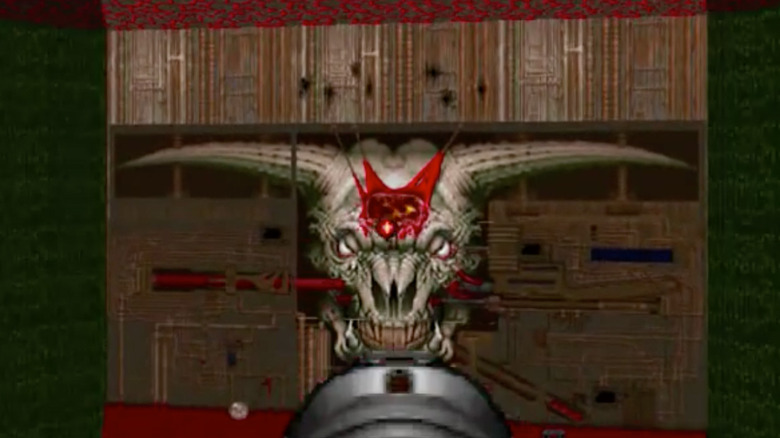Disappointing Final Levels That Almost Ruined Great Games
A great final level can be the icing on the cake of a great video game, and can even elevate a mediocre one by putting everything together in a way that makes it all feel worth it. A thrilling, climactic boss fight, a puzzle that uses everything you've learned so far, or even just a difficult test of skill can be the final piece that makes a good game great, and a great game into an all-time classic. And sadly, that's not always what we get.
Even great games are prone to stumbling at the finish line, whether it's from shifting into a completely different genre, collapsing under the weight of a flawed narrative, or just straight-up sucking the fun out of it with an endless, frustrating grind. Whatever the case, it happens more often than you might think, as evidenced by these great games that were almost ruined by their disappointing final levels.
Devil May Cry
The original Devil May Cry provided gamers with one of the most memorable experiences of its generation. A slick supernatural adventure that involved juggling enemies with a giant sword and a pair of handguns that never seemed to run out of bullets, its blend of high action in a horror movie castle somehow had as much style as it did substance.
And then, for some reason, in the last level, it turns into a flight simulator. No swords, no combos, just a sequence after the final boss where you have to awkwardly fly a biplane through a cave, which is a) a sudden shift of genre that's never even hinted at in the game up to that point, and b) something that's rendered completely redundant when you see the same thing happening right after in a cut-scene. It doesn't break the game, but it's weirdly out of place, and annoying enough that it undercuts all the fun of the boss fight, which is actually pretty great.
Fortunately, game designer Hideki Kamiya also made Bayonetta, and that's a game that ends with a level where you ride a motorcycle up the side of a building that's been shot into space and then literally punch out God, which actually makes sense based on the game leading up to it — or as much sense as anything else does in that game, anyway. The lesson? If you're gonna get weird, at least go big.
L.A. Noire
Speaking of games that take an alarming genre shift in the final act, we have L.A. Noire, a game that doesn't just switch things up at the end, it pretty much rejects its own premise.
Set in a beautiful digital recreation of Los Angeles in 1947, L.A. Noire allows players to collect evidence and conduct interrogations. Players rooted out the lies that witnesses and criminals hid behind by carefully considering the facts and watching for their tells. It's a great concept — so great, in fact, that Phoenix Wright did it earlier, better, and without being so pretentious, but that's a subject for another time. Unfortunately, the whole thing falls apart in the last level, when L.A. Noire decides it wants to be a bad shooter where you run through the sewers with a flamethrower.
Sell-designed games teach you how to play as you play. They provide you with a difficulty curve that requires getting better at the core mechanics until you're faced with a challenge where you can put it all together. This game, on the other hand, spends hours emphasizing investigation and telling the difference between half-truths and outright lies, and then suddenly freaks out at the last minute and goes "Hey! You kids like Grand Theft Auto, right? Right?!"
Batman: Arkham City
The final boss fight of Batman: Arkham Asylum comes up a lot when people discuss bad endings to great video games. The Joker's scheme throughout the game was apparently to lure Batman to a rooftop and jack himself up on venom, turning himself into exactly the kind of giant monster Batman's been kicking the crap out of for twelve solid hours. That's not exactly a great plan — and that's before you get to the part where the World's Greatest Detective decides the best way to deal with the situation is to spray a bunch of plastic explosives on his own hands so that he can explode-punch the Joker in the face. All these years, and it turns out that Batman actually does have a super-power: bomb-proof knuckles.
Honestly, though? That kind of over-the-top (and frankly pretty stupid) action worked really well in the Arkham series. As goofy as it seems, it's still Batman stopping a major threat. The sequel, however, tried to push the envelope further, ending up with a plot twist that's genuinely infuriating if you take two seconds to actually think about it.
The boss fight itself is fine, because Clayface makes a whole lot more sense as a giant monster than the Joker. The action that leads up to it, though, is incredibly frustrating. Batman spends hours prowling around the walled-off section of Gotham that's been turned into a massive prison, trying to stop the bad guys and save trapped, innocent citizens. Then the villains just air strike the city, which, according to in-game dialogue, kills hundreds of people — the same people you've been rescuing and protecting this whole time. Now everything you've done in the game is rendered completely pointless. It's fine to get weird and silly at the end. But nobody likes to feel like they've been wasting their time. Especially Batman.
Fallout: New Vegas
The Fallout series, as awesome as it is, has always struggled at the finish line. Fallout 3, for instance, was notable for ending its main plot by killing the player character with radiation poisoning, railroading them into that destiny even if you'd taken the time to get a sidekick who was completely immune to that particular hazard. It's so bad that they ended up retconning it in the Broken Steel expansion, where you wake up just fine and then team up with a giant robot armed with literal nuclear footballs to bring down the bad guys once and for all.
The next game, while rightly considered a masterpiece, didn't fare much better in that particuar arena. The plot inexorably moved towards a massive conflict between three factions set at the Hoover Dam. While there was one storyline thread that allowed the main character to act somewhat independently, the truth is that there wasn't much players could do to change anything.
For the entire game, you're given bits of information about Caesar's Legion being held together only by Caesar himself, through force of will and a cult of personality. But even if you walk right into Caesar's camp, shoot him in the face, and wipe out all of his men — something that's not only possible, but actually pretty easy if you've put in the time to level up — it has no effect on the story and you're still left with the same kinda boring choices at the end. For a game so good at giving players the illusion that they're shaping the world around them, any step away from that quest line shows just how little you can actually do.
Mass Effect 3
With a plot built around gearing up for the final conflict against the Reapers, you take a journey in Mass Effect 3 that gives closure on pretty much everything you'd done in the previous two installments. The Krogan genophage, Cerberus and their racist goals for galaxy dominated by humans at any cost, the Quarians' exile from their homeworld–one way or another, paragon or renegade, you wrap it all up by the end of the saga.
Unfortunately, it doesn't give you closure where it counts the most: at the end of the actual game. In a saga defined by showing you the consequences of your choices, the last thing you do is make a decision that, while presented as epic and definitive for the universe of the games, doesn't actually affect you as the player, because you're not around to see it. Even worse, it's a choice that's presented by a literal deus ex machina, and relies on you to prioritize narrative over experience, something many fans found underwhelming.
The immediate run-up to the choice doesn't fare much better. After spending three games refining its shooter mechanics into an action-RPG that balanced combat and conversation, Mass Effect 3 doesn't really provide you with that epic conflict at the end. Shepard stumbling through the battlefield, injured and armed only with a pistol but refusing to quit when the mission hasn't been completed? That's an awesome idea. But the last "boss" you fight at the conclusion of an epic trilogy is a standard enemy who goes down in about two shots. That's always going to be a bit of a letdown, even if the "Marauder Shields" meme that it spawned was pretty funny.
Sonic the Hedgehog
Frustrating final levels aren't just something that you get from the current-generation, even if they tend to fall into that trap pretty often. Take, for instance, the final act of Sonic the Hedgehog, which has been ruining your day since 1991.
For a game where the main attraction is that you, well, gotta go fast, the Scrap Brain Zone slows things down to a crawl, lining its corridors with traps that'll catch you if you accelerate even a little bit past a slow jog.
That in itself isn't necessarily a bad thing — a hallmark of a good final level is that it makes you figure out how to use your character's abilities in a new way. But a lot of those traps cross the line from "challenging" to "cheap" and turn the whole thing into a grind. Having to be careful is one thing, but when the entire draw of your game is fast-paced, frenetic action, having to inch across the level to avoid a flamethrower hidden right off the edge of the screen just isn't fun.
And here's the cherry on top: your reward for all that careful plodding? Not a boss fight where you get to open up and run Dr. Robotnik down at high speed, but a basic, pretty easy death trap where you actually have to stand still to avoid the traps. That's like making a Mario game that ends with a level where you can't jump.
Doom II
DOOM didn't invent the first-person shooter, but it sure as hell defined it, influencing countless knockoffs and propelling an entire genre to worldwide popularity. Even decades later, the combination of outer-space sci-fi and demonic horror is incredibly memorable, and the first game's climactic battle against a colossal spider-demon was the source of plenty of nightmares after late-night gaming sessions. So naturally, the second game would have a monster even more horrifying and harrowing, right? Uh... not exactly.
At the end of DOOM II, you fight a wall.
To be fair, it's a big wall. And it's surprisingly difficult to kill as walls go, because it's only vulnerable in a single tiny spot that you have to hit with a rocket launcher to damage the weak point within. The real challenge comes from an the monsters that spawn infinitely around it, one of the most annoying tricks a game can pull off. The good news is that you can always just cheat and go behind the wall to attack the weak point directly — although if you do, you'll find out that the actual "Icon of Sin" is a digital recreation of game designer John Romero's head. Games in the '90s were weird.
Assassin's Creed III
The weirdest thing about the Assassin's Creed games as a franchise is that they build these beautiful recreations of different times and places, load them up with characters influenced by actual history, and combine them with a centuries-spanning saga that mixes religion and sci-fi. Then they frame it all by making you play as some other guy who's actually playing the video game in a weird virtual reality pod, and occasionally interrupts your game to make you do things that don't involve suspiciously acrobatic stabbing. That's Desmond: everyone's least favorite part of the franchise.
With that in mind, you might think that when the game finally killed him off, it came as something of a relief. But even that winds up being a lackluster epilogue that interrupts the actually compelling story of the game's real lead character, Connor. And at the end of the day, the death of a guy you've technically spent five games playing as, who's been hinted at as this destined hero meant to save the world from destruction at the hands of the Templars, just sort of touches an orb and crumples to the ground. The End.
Either way, it doesn't live up to the finales of the other games in the franchise. Of course, that's to be expected: Assassin's Creed II ended with Ezio Auditore having a fistfight with the pope in the Vatican's secret alien technology basement. That's kind of tough to top.
Rise of the Tomb Raider
Under normal circumstances, building an entire game around an explicit origin for why Lara Croft carries two guns — as opposed to just being like, "she wants to shoot twice as many things" and leaving it at that — would've been a disaster. The excellent 2013 Tomb Raider reboot, however, managed to pull the whole thing off, showing a young Lara Croft overcoming impossible odds that start with being impaled on a rusty piece of rebar and just get bigger from there. She finally grows into the butt-kicking, tomb-raiding character that we all know by the end. It's that rare bit of storytelling that works so well that it makes a quick time event feel worth it.
This new Lara's second outing, however, doesn't go quite as well. Despite filling the game with beautiful settings, a compelling story, great action, and a surprisingly robust crafting system, it doesn't quite stick the landing. After a game built around scrounging, scrapping, and surviving, the last act just turns into a cover shooter.
Good thing the Yamati kingdom built so many of their temples out of waist-high walls that were easy to duck behind, huh?
Fable II
Fable II is a great game. Its epic quest starts when you're defenestrated from a castle as a child and ends when you confront a world-shattering evil. Its cleverly designed setting features a population of NPCs best described as "charmingly terrible," and it has plenty of fun side quests and distractions throughout. There's even a cute dog to serve as your best friend!
And it also has one of the most frustrating and ultimately nonsensical last moments ever.
After finally conquering the Tattered Spire, a process that involves spending ten years of your in-game life undercover as a guard and potentially sacrificing even more of your youth to keep Stephen Fry alive for another century (long story), you're confronted with a final boss that goes down in a single shot from your gun. That is, admittedly, pretty cathartic. But if you wait long enough to actually hear if he has anything to say — something that's actually pretty likely, considering how much of the game is built on interactive conversations with NPCs — someone else steps in to kill him and rob you of the revenge you've been working for in-game decades and real-life hours. And that's not even the bad part.
Once that's all over, the game gives you a choice of reward. You can get money, which is pointless at that point in the game. You can return everyone to life that was killed by the bad guys with the sole exception of your sister and your dog, who takes a bullet for you in the final battle. Or you can get your sister and your dog back. A narrative about sacrifice and heroism is one thing, but let's be real for a second: are you really saying that a wish to bring countless thousands back to life is functionally the same as resurrecting one person and one dog?
It's the kind of game where you want to choose the "selfish" option purely out of spite, or at least interrupt them with "I want my dog" before they even finish speaking.



